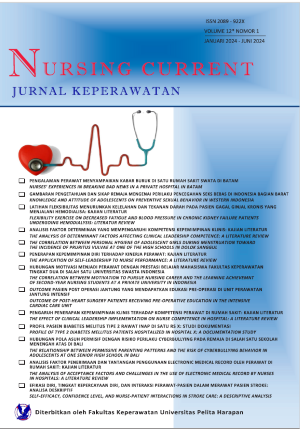OUTCOME PASIEN POST OPERASI JANTUNG YANG MENDAPATKAN EDUKASI PRA OPERASI DI INTENSIVE CARDIAC CARE UNIT [OUTCOME OF POST-HEART SURGERY PATIENTS RECEIVING PRE-OPERATIVE EDUCATION IN THE INTENSIVE CARDIAC CARE UNIT]
DOI:
https://doi.org/10.19166/nc.v12i1.8339Kata Kunci:
education, patient outcomes, preoperative cardiac orientationAbstrak
Cardiac surgery is an intervention to correct and improve the anatomy and function of the heart. The preparations made by the nurse include conducting an orientation involving introduction to the operating room and post-surgery, education to deal with anxiety and postoperative pain, deep breathing exercises and effective coughing, spirometry incentive exercises, and early mobilization so that the patient understands what will be experienced before and after the procedure in the intensive care unit. This study aimed to determine the outcome of post-cardiac surgery patients who received care education in a pre-operative orientation at the ICCU, a private hospital in western Indonesia. This research used a quantitative descriptive design and univariate statistical analysis with a sample size of 15 participants using an accidental sampling technique. The instruments used were pain measurement observation sheets with a numerical scale, spirometry to measure lung volume capacity, and mobilization observation checklists, as well as the Hospital Anxiety Depression Scale questionnaire to measure anxiety. All participants received preoperative education. The results showed that all participants experienced decreased pain levels and could mobilize early, gradually from 24 to 72 hours post-surgery. A total of 10(66.67%) participants had a mild level of anxiety 24 hours after heart surgery, and 11(73.34%) participants experienced a consistent increase in lung volume capacity. Pre-cardiac surgery education provides the expected post-operative outcomes: decreasing pain and anxiety levels, increasing lung volume capacity, and gradual mobilization.
BAHASA INDONESIA Bedah jantung adalah suatu tindakan operasi untuk mengoreksi dan memperbaiki anatomi dan fungsi jantung. Persiapan yang dilakukan perawat adalah melakukan orientasi meliputi pengenalan ruangan tindakan dan post operasi, edukasi untuk mengatasi kecemasan dan nyeri post operasi, latihan nafas dalam dan batuk efektif, latihan insentive spirometri serta mobilisasi dini, sehingga pasien memahami apa yang akan dialami sebelum dan sesudah tindakan operasi di ruangan intensif. Penelitian ini bertujuan untuk mengetahui gambaran outcome pasien post operasi jantung yang menerima edukasi perawatan dalam orientasi pre operasi di ICCU salah satu rumah sakit swasta di Indonesia bagian barat. Penelitian ini menggunakan desain deskriptif kuantitatif dan analisis statistik univariat dengan jumlah sampel 15 partisipan menggunakan tehnik accidental sampling. Instrumen yang digunakan berupa lembar observasi pengukuran nyeri dengan skala numerik, spirometri untuk mengukur kapasitas volume paru, dan ceklis observasi mobilisasi, serta kuesioner Hospital Anxiety Depression Scale untuk mengukur kecemasan. Seluruh partisipan mendapatkan edukasi pre operasi. Hasil menunjukkan seluruh partisipan mengalami penurunan tingkat nyeri dan mampu mobilisasi dini bertahap dari 24 jam sampai 72 jam post operasi. Sebanyak 10(66,67%) partisipan memiliki kecemasan tingkat ringan pada 24 jam post bedah jantung, dan 11(73,34%) partisipan mengalami kenaikan kapasitas volume paru secara konsisten. Edukasi pre operasi jantung memberikan outcome post operasi yang diharapkan yakni penurunan tingkat nyeri dan kecemasan, kenaikan kapasitas volume paru dan mobilisasi secara bertahap.
Referensi
Ariaty, G. M., Sudjud, R. W., & Sitanggang, R. H. (2017). Angka mortalitas pada pasien yang menjalani bedah pintas koroner berdasar usia, jenis kelamin, left ventricular ejection fraction, Cross Clamp Time, Cardiopulmonary bypass time, dan penyakit penyerta. Jurnal Anestesi Perioperatif, 5(3), 155-162. https://doi.org/10.15851/Jap.v5n3.1167
Astuti, I. D., Akbar, M. R., & Nuraeni, A. (2019). Intervensi rehabilitasi jantung fase I pada pasien yang menjalani operasi bedah pintas koroner (BPK): Literatur review. Jurnal Keperawatan Indonesia, 22(2), 110- 121. https://doi.org/10.7454/jki.v22i2.726
Awaludin, S., Afni, A. C. N., & Sekarwati, W. (2018). Hubungan kecemasan dengan kualitas hidup pasien post coronary artery baypass graft (CABG) di ruang rehabilitasi jantung Rumah Sakit Jantung dan Pembuluh Darah Harapan Kita Jakarta. Jurnal Kesehatan Kusuma Husada, 9(2), 243-247. https://jurnal.ukh.ac.id/index.php/JK/article/view/286
Berampu, S., & Alamsyah, I. (2018). Incentive spirometry and deep breathing exercise prefer to prevent decreased of lung vital capasity as good as deep breathing exercise post Coronary Artery Bypass Graft phase I. Jurnal Keperawatan dan Fisioterapi, 1(1), 36- 46. https://doi.org/10.35451/jkf.v1i1.50
Hamdiah, D., & Budiyanto, A. (2022). Hubungan antara nyeri dan kecemasan dengan kualitas tidur pada pasien post operasi di ruang bedah. Ghidza: Jurnal Gizi dan Kesehatan, 6(2), 191-199. https://doi.org/10.22487/ghidza.v6i2.564
Moradian, S. T., Najafloo, M., Mahmoudi, H., & Ghiasi, M. S. (2017). Early mobilization reduces the atelectasis and pleural effusion inpatients undergoing coronary artery bypass graft surgery: A randomized clinical trial. Journal of Vascular Nursing, 35(3), 41145. https://doi.org/10.1016/j.jvn.2017.02.001
Senst, B., Kumar, A., & Diaz, R. R. (2022). Cardiac surgery. https://www.ncbi.nlm.nih.gov/books/NBK532935/
Sugiyono, S., Irawati, D., & Natashia, D. (2022). Implementasi evidence based nursing: Efek mobilsasi dini pada peningkatan fungsi fisik pada pasien paska bedah jantung (CABG). Journal of Telenursing, 4(2). https://doi.org/10.31539/joting.v4i2.3303
Suherwin, S. (2016). Hubungan usia, jenis kelamin dan riwayat penyakit dengan kejadian penyakit jantung koroner di Instalasi Gawat Darurat Rumah Sakit Tk II DR. AK. Gani Palembang. Jurnal Aisyiyah Medika, 1. https://doi.org/10.36729/jam.v1i1.248
Vervoort, D., Lee, G., Ghandour, H., Guetter, C. R., Adreak, N., Till, B. M., & Lin, Y. (2024). Global cardiac surgical volume and gaps: Trends, targets, and way forward. Annals of Thoracic Surgery Short Reports, 2(2), 320-324. https://doi.org/10.1016/j.atssr.2023.11.019
World Heart Federation. (2024). Cardiovascular Diseases-Global Facts and Figures. https://world-heart-federation.org/resource/cardiovascular-diseases-cvds-global-facts-figures/
World Health Organization. (2021). Cardiovascular diseases (CVDs). https://www.who.int/news-room/fact-sheets/detail/cardiovascular-diseases-(cvds)
Unduhan
Diterbitkan
Cara Mengutip
Terbitan
Bagian
Lisensi
Hak Cipta (c) 2024 Elizabeth Friska Hasibuan, Vincentia Puspasari Adi, Sri Budi Susanti, Marisa Junianti Manik, Elysabeth Sinulingga

Artikel ini berlisensiCreative Commons Attribution-ShareAlike 4.0 International License.
Authors who publish with this journal agree to the following terms:
1) Authors retain copyright and grant the journal right of first publication with the work simultaneously licensed under a Creative Commons Attribution License (CC-BY-SA 4.0) that allows others to share the work with an acknowledgement of the work's authorship and initial publication in this journal.
2) Authors are able to enter into separate, additional contractual arrangements for the non-exclusive distribution of the journal's published version of the work (e.g., post it to an institutional repository or publish it in a book), with an acknowledgement of its initial publication in this journal.
3) Authors are permitted and encouraged to post their work online (e.g., in institutional repositories or on their website). The final published PDF should be used and bibliographic details that credit the publication in this journal should be included.

This work is licensed under a Creative Commons Attribution-ShareAlike 4.0 International License.






